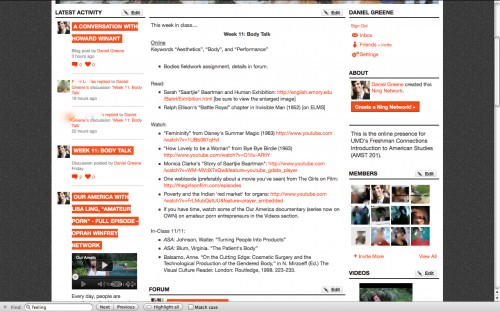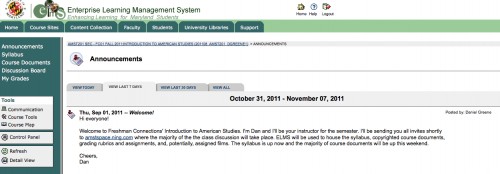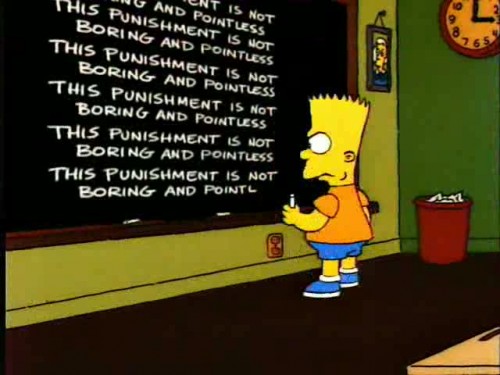In this space, about a month and a half ago, I laid out my design and pedagogy strategies for my mixed online/in-person AMST 201: Introduction to American Studies course. These strategies all hinged on the core idea of a building an augmented syllabus for an augmented reality: Web-based, in-class, and other tools each have their own strengths and weaknesses which can support or hamper learning objectives. In order to help students apply new ideas to their everyday lives, I’ve tried to
- Lead with the practice of big course themes rather than graduate-level theory about them
- Build safe spaces for engagement that reward multiple forms and levels of engagement
- And to implement all course-related technologies (e.g., the online Ning network, podcasts specific readings or films, audiovisual materials for small-group work in class) with the prior two ideas in mind.
For the most part, there hasn’t been much student pushback and class is going well. Midterm exam grades were above average, and student responses to my midterm feedback form—which included technology-focused questions—were generally positive. That feedback is crucial, not just self-check data but a way to keep emphasizing the importance of transparency to the learning process. Keeping my core ideas and strategies in mind, I want to draw from student feedback and my own observations and experiences to review what’s worked so far, what hasn’t, and what can change.
Students seem to enjoy our Ning network more than Blackboard or equivalent LMS’s Part of this, they say, is layout: colorful, readable, and personal versus textual, crowded, and confusing. This is not to be scoffed at, layout, and visual design in general, helps students spend more time learning and less time searching, and an appealing, quick-loading space will, at minimum, make homework seem like less of a chore. Which of the below looks more welcoming, makes it seem like there’s more going on?


Students also recognize that Ning is their space to play around with these ideas, before they see them used in research during Friday’s 75-minute discussion. As one feedback form put it, “The Ning space is easy to access and seems less pressured. It’s easier to express idea [sic] in a less stressful environment like a blog.” More importantly, the big plan of getting students comfortable with uncomfortable issues online (e.g., structural racism, the prevalence of binary thinking, the life-and-death consequences of both) before hashing out the difficult portions in class seems to be paying off. There’s a lot of individual variation but it’s clear that, even within individual weeks, the students who put in the time designing an argument online, comparing it with other people, linking it to various texts, and responding to criticism have a better handle on the big themes and ideas. This is true whether their initial argument was solid gold or total garbage. No rocket science here—students who work harder should do better—but the point is they have a safe space to do so, without feeling the need to prove themselves in a theory-driven classroom that has little relation to the outside world and only a few ways to demonstrate comprehension.
I see students playing to their strengths generally. Those with an empirical bent shine on data-focused weeks. Those who prefer to work autobiographically give plenty of personal detail when we’re talking about the structures of feeling concerning fields like disability. Non-native English speakers and students who feel especially uncomfortable speaking up in class have a bigger presence in the forums than they do in the classroom. Everyone says they appreciate examples from everyday texts (e.g., news, television, music) that link every week to the historical or theoretical big picture, and this fits with my goals: Critiquing and crafting examples is the real meat of the course, not the research or theory texts. I want students to leave the class with a toolkit to evaluate social texts and social problems. And practice makes perfect. In class I keep referring back to examples from online discussion, and encourage students to do the same.

There have been plenty of bumps in the road though, some intrinsic to teaching first-semester freshman in any 200-level class, some particular to my design decisions and which I can definitely work with in the rest of the semester.
The majority of students did not expect the rigor to be at the level it is. They’re doing fine with it but my syllabus didn’t so much trim the research as add real-world application and context. My university stresses that three-credit courses should include about six to nine hours of out-of-class work and my department chair stresses around 100 pages of reading a week for three credits. For this course, some weeks have more work and some less, but I aim to meet those time and page counts—with the important caveat that films, music, fieldwork, writing, and studying could all substitute for reading. Beyond rigor-shock, there’s also the usual freshmen issues: students aren’t especially vocal early on Friday mornings, there are learning curves around timeliness and other syllabus-mandated procedures, and of course there will always be some students who just prefer not to attend or who have serious issues with formulating and expressing an argument that should have been addressed in high school. I give gentle reminders and encouragement around all these—especially with the basics of argumentation and research—but try to keep focused on the meat of the class: the study of culture. If there’s one thing I learned from working in community mental health clinics it’s that if you blame yourself for everything the folks you’re working with do, then 1) you start a never-ending guilt trip and 2) you de-emphasize the agency and independence of the other members of your community.
But there’s definitely some other design issues that are within my sphere of control. At different places in the feedback form, multiple students complained about the repetition of weekly 250-word forum posts, with focused arguments and relevant evidence. It’s an important skill, but there’s more than one way to skin an historic bloc. In the second half of the semester, I’m introducing more participant-observation exercises, discussions of the early stages of long-term projects, and group research into new or pending legislation. This week on the syllabus, titled ‘Body Talk’, includes a fieldwork assignment to spend time in a place where your body normally wouldn’t feel comfortable (e.g., men hang out in Victoria’s Secret, students without tattoos or piercings could spend time at a tattoo shop) along with regular course activities:
This week in class….
Week 11: Body Talk
Online
Keywords “Aesthetics”, “Body”, and “Performance”
- Bodies fieldwork assignment, details in Forum.
Read:
- Sarah “Saartjie” Baartman and Human Exhibition: http://english.emory.edu/Bahri/Exhibition.html [be sure to view the enlarged image]
- Ralph Ellison’s “Battle Royal” chapter in Invisible Man (1952) [on ELMS]
Watch:
- “Femininity” from Disney’s Summer Magic (1963) http://www.youtube.com/watch?v=1UBb087qHvI
- “How Lovely to be a Woman” from Bye Bye Birdie (1963) http://www.youtube.com/watch?v=O1ilu-ARtiY
- Monica Clarke’s “Story of Saartjie Baartman”: http://www.youtube.com/watch?v=WM-MVdX7sQw&feature=youtube_gdata_player
- One webisode (preferably about a movie you’ve seen) from The Girls on Film: http://thegirlsonfilm.com/episodes
- Poverty and the Indian ‘red market’ for organs: http://www.youtube.com/watch?v=FrLMubQstUU&feature=player_embedded
- If you have time, watch some of the Our America documentary (series now on OWN) on amateur porn entrepreneurs in the Videos section.
In-Class 11/11:
- ASA: Johnson, Walter. “Turning People Into Products”
- ASA: Blum, Virginia. “The Patient’s Body”
- Balsamo, Anne. “On the Cutting Edge: Cosmetic Surgery and the Technological Production of the Gendered Body,” in N. Mirzoeff (Ed.) The Visual Culture Reader. London: Routledge, 1998. 223-233.
So the forum remains a place to refine or complicate ideas, but producing those ideas should involve multiple skill sets. I’m also going to try to incorporate that belief into in-class activities. In several classes I’ve broken students into small groups to work with short videos or to debate other groups on the merits of certain research. It’s become clear—especially on the week around race, space and Hurricane Katrina—that getting students to open up about affective reactions to texts or biographical links to texts is quite productive, so journaling and sharing will pop up more. Students generally say the offline and online work complement each other, but I want to expand the ways in which they do so—especially when it comes to moving beyond the Ivory Tower. Recall and reuse is always enhanced if information is processed along multiple, self-referential pathways.
To encourage students to work with their own ideas and strengths, I tend to be explicit in how they’ll be graded but more open as to how they can approach different ideas. I encourage and model narrow, specific arguments with evidence but, still, it’s clear that some students prefer explicit instructions on how to complete an assignment. That’s fine, and I usually meet those needs with more individualized feedback on the boards rather than changing everyone’s assignments in every space. These frustrations can also be addressed by making use of the most important technology augmenting any syllabus: the teacher’s office. But only one student has come to office hours thus far.

Negotiating a learning space with multiple technological dimensions has been a learning experience for me and my students, and I’ll want perform another check-up at the close of the semester. I already know that Ning is an improvement over Blackboard in facilitating student engagement, but at the end of the day it’s still Ning’s and not mine or my students. So I’ll be considering how to design my own space to meet the same goals, and would love to hear more from the hivemind about experiences with linking teaching spaces to your own Web presence.


Comments 1
genemorrow — December 9, 2011
Sounds really interesting! As an undergrad, I know how hard it is to have the chance to enjoy in depth discussions with my peers outside of class, and the online component sounds like an amazing addition to any class!
And if it makes you feel any better, my experience is that almost no one ever goes to office hours. I don't know why, but it seems like a trend!